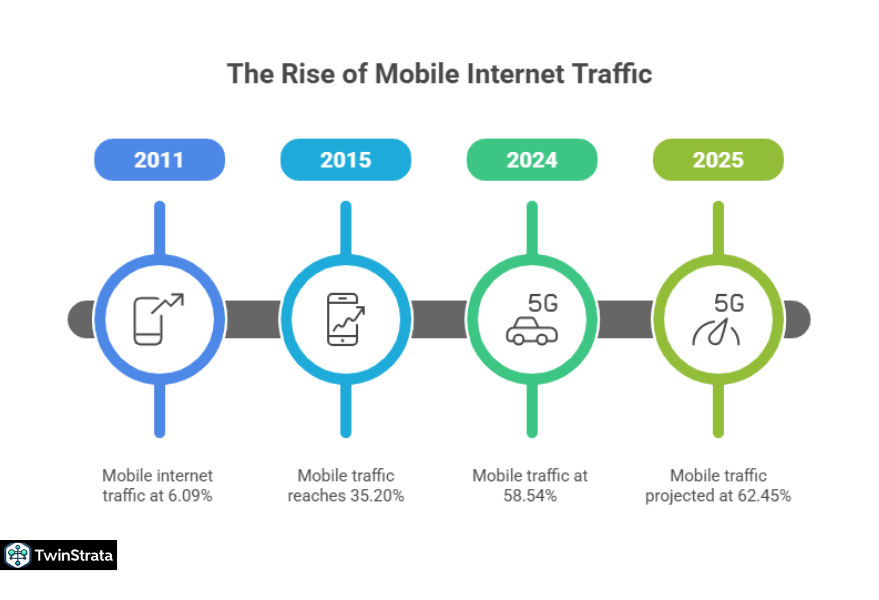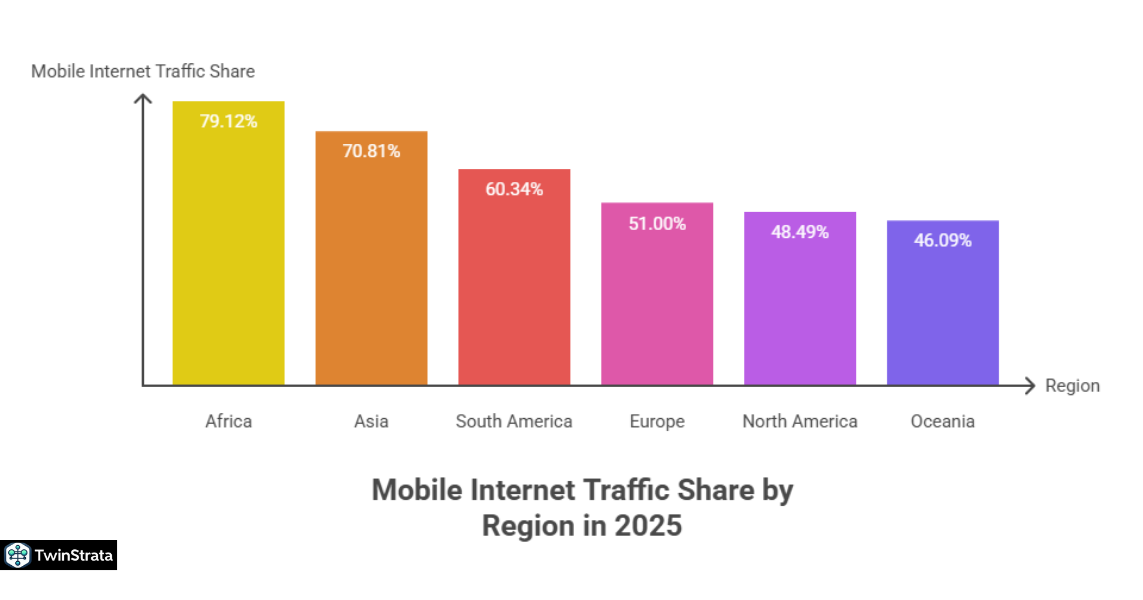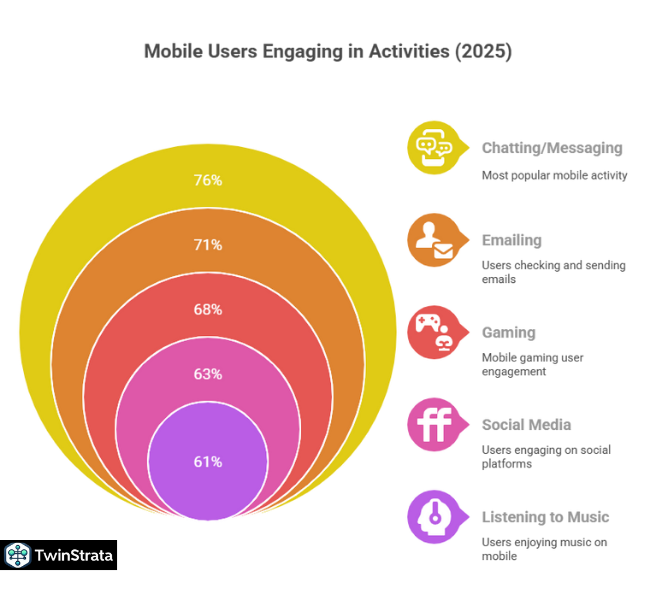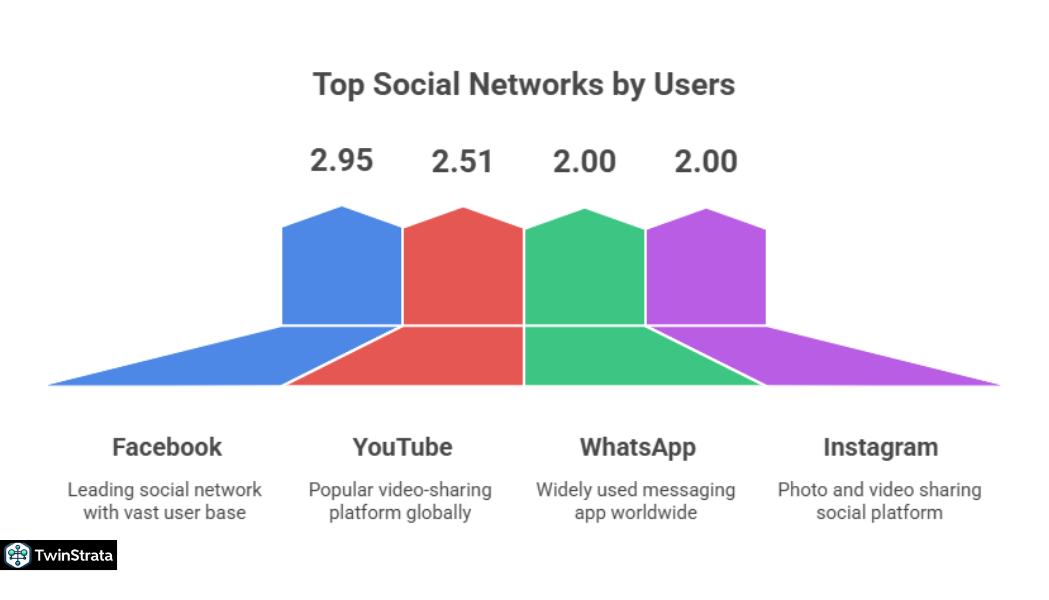Mobile devices shape how people connect to the internet today. People use smartphones and tablets for everything from chatting with friends to shopping online.
In 2025, mobile internet traffic statistics show that over 64% of all global web traffic comes from mobile devices. This shift changes how businesses operate and how individuals stay informed.
Readers who want to learn more about mobile internet traffic statistics 2025 can use this data to improve their online strategies. For example, website owners optimize sites for mobile to attract more visitors and boost sales.
Experts predict even more growth in mobile usage. Businesses benefit by creating mobile-friendly apps and ads. Individuals save time and data by understanding usage patterns.
This article combines key statistics from worldwide sources. It includes tables for easy reading and details on how you apply this information. We also add fresh insights from Quora and Reddit discussions. Users on these platforms ask about data consumption and future trends, providing real-world views.
Table of Contents
ToggleGlobal Mobile Internet Traffic Overview

People around the world rely on mobile devices for internet access. In 2025, mobile devices generate 62.45% of all global internet traffic. This number rises from 58.54% in 2024. Desktop computers handle the rest, but mobile leads the way. Users prefer mobile for its convenience. You access information anytime, anywhere.
The total mobile internet traffic increases yearly. From Q1 2022 to Q1 2025, it grows by about 1.5%. This growth comes from more users and better networks. In the United States, mobile traffic reaches 48.5% in 2025, up slightly from 47.79% in 2024. Businesses track these stats to target ads effectively.
Here is a table showing global mobile internet traffic share from 2011 to 2025:
| Year | Mobile Internet Traffic Share |
| 2011 | 6.09% |
| 2012 | 10.88% |
| 2013 | 17.02% |
| 2014 | 28.97% |
| 2015 | 35.20% |
| 2016 | 43.66% |
| 2017 | 51.58% |
| 2018 | 50.81% |
| 2019 | 50.43% |
| 2020 | 51.61% |
| 2021 | 55.01% |
| 2022 | 56.37% |
| 2023 | 57.67% |
| 2024 | 58.54% |
| 2025 | 62.45% |
Source: Statista
This table highlights the steady rise. Mobile traffic jumps after 2015 due to affordable smartphones. You use this data to plan marketing. For instance, invest in mobile ads to reach more people.
Globally, over 5.56 billion people use the internet in 2025. About 96.3% access it via mobile phones. This leaves few without mobile connectivity. Mobile internet users total around 5.3 billion in 2024, rising to 5.5 billion in 2025. Projections show 5.8 billion by 2026.
The average smartphone consumes 21.1 GB of data per month in 2025. This doubles from 10 GB in 2020. Streaming videos and social media drive this usage. On Reddit, users discuss high data needs. One thread from r/DigitalWorkspace1 notes global mobile data traffic triples by 2030. This means networks must expand fast.
Businesses benefit by offering data-efficient services. Apps that compress images save users money. Individuals monitor usage with phone tools to avoid overages.
- Also read about: Internet Usage Statistics
Mobile Internet Traffic by Region

Regions differ in mobile reliance. Africa leads with 79.12% mobile traffic in 2025, up from 69.13% earlier estimates. People there use mobile devices more due to limited access to desktops. Asia follows at 70.81%, with countries like India at 75.09%.
In North America, mobile accounts for 47.59% in 2024, rising to 48.49% in 2025. Europe sees 50.64% in 2024, increasing to 51% in 2025. South America hits 60.34%, and Oceania lags at 46.09%.
Here is a table of mobile internet traffic share by region in 2025:
| Region | Mobile Internet Traffic Share |
| Africa | 79.12% |
| Asia | 70.81% |
| South America | 60.34% |
| Europe | 51.00% |
| North America | 48.49% |
| Oceania | 46.09% |
Source: StatCounter
Nigeria tops countries with 83.94% mobile traffic. Indonesia reaches 98.7% penetration. You use regional data for targeted campaigns. A business in Africa focuses on mobile apps for better reach.
Mobile Device Usage and Activity Statistics

People spend more time on mobile devices. In 2025, users average 56.03% of online time on mobile, up from 53.05% in 2021. Over 7.49 billion mobile users exist globally. In the US, 287.5 million use mobile internet, projected to 296.18 million in 2025.
Activities vary. 76% chat or message, 71% email, and 61% listen to music. Gaming attracts 68%, with 3 billion mobile gamers.
Here is a table of top mobile activities in 2025:
| Activity | Share of Users |
| Chatting/Messaging | 76% |
| Emailing | 71% |
| Listening to Music | 61% |
| Online Banking | 61% |
| Watching Videos | 61% |
| Gaming | 68% |
| Social Media | 63% |
You apply this by creating content for popular activities. A music app developer adds offline features to save data.
Searches on mobile dominate. 96% come from Google. 41% of shoppers search in stores. Use this for local SEO. Optimize keywords like “near me” to drive foot traffic.
- Also read about: Google Searches Statistics
E-commerce and Mobile Statistics

Mobile drives e-commerce. In 2025, 72% of US retail site traffic is mobile. Sales from mobile reach $710.42 billion, up from $511.8 billion in 2023. Global online shoppers total 2.64 billion.
Mobile commerce shares 35.25% of digital spending. You benefit by making checkout mobile-friendly. Reduce cart abandonment and increase sales.
Here is a table of US mobile e-commerce sales from 2019 to 2025:
| Year | Sales (Billion USD) |
| 2019 | 220.67 |
| 2020 | 311.93 |
| 2021 | 362.11 |
| 2022 | 431.4 |
| 2023 | 511.8 |
| 2024 | 604.5 |
| 2025 | 710.42 |
Social Media, Email, and Gaming on Mobile

Social media thrives on mobile. 4.76 billion users access via phones. Facebook leads with 2.95 billion active users. 90% in US use mobile for social.
Here is a table of top social networks by users in 2025:
Email sees 333.2 billion daily sends. 71% check on mobile. Gaming market hits $103.5 billion. Stumble Guys leads downloads.
You leverage this by advertising on social apps. Gamers respond to in-app ads.
5G and Broadband Statistics
5G connections will exceed 1 billion in 2025. China leads with 866 million. US has 247 million. 68% of US users on 5G by 2025.
Mobile data usage: 84.5 exabytes on 2G-4G, 31 on 5G monthly.
Here is a table of global mobile data by network from 2018 to 2025:
| Year | Fixed Wireless (Exabytes) | 5G Mobile (Exabytes) | 2G-4G Mobile (Exabytes) |
| 2018 | 4.4 | 0 | 22.2 |
| 2019 | 6.2 | 1.3 | 33.4 |
| 2020 | 9.7 | 1.7 | 47.2 |
| 2021 | 16.6 | 6.7 | 60.9 |
| 2022 | 24.4 | 15.2 | 74.8 |
| 2023 | 33.4 | 31 | 84.5 |
| 2024 | 45.8 | 50.7 | 95.4 |
| 2025 | 61.8 | 79.2 | 104.4 |
5G speeds up to 539 Mbps in UAE. You benefit with faster apps for real-time services.
What people are asking? Key insights
From Quora:
- What internet speeds will we see in the next 10 years? What broadband speed will be a norm? This question discusses projections for mobile and broadband speeds, with answers noting that 10Gbit/s could become mainstream by 2035, but mobile 5G/6G will drive everyday norms around 1Gbit/s for most users. It’s relevant for understanding how faster networks boost mobile traffic in 2025.
- How much data is transferred on the Internet on a daily basis? Users here estimate global daily data transfer at trillions of gigabytes, with mobile contributing over 60% in recent years. Answers reference 2020-2025 growth rates, highlighting mobile streaming as a key driver—perfect for tracking exabyte-level mobile stats.
- Can we lose Internet in 2025 permanently? This explores resilience of mobile networks amid potential disruptions, with responses emphasizing how 5G’s distributed design ensures over 1 billion connections stay robust. It ties into 2025 mobile traffic reliability stats.
From Reddit:
- Detailed data for Best Mobile Network in US | Speed Test Award 2025 (from r/cellmapper) Posted in July 2025, this thread shares stats on US mobile speeds and coverage, debating T-Mobile’s edge in 5G traffic handling. Users discuss real-world data usage spikes, making it a goldmine for 2025 regional mobile benchmarks.
- TIL In 2024, bots made up a bigger proportion of global internet traffic than humans for the first time (from r/todayilearned) Shared in July 2025, comments analyze how bots inflate traffic (over 50% globally), with mobile bots from apps contributing heavily. It connects to 2025 forecasts where human mobile traffic still dominates at 64% but faces bot interference.
- Half of online traffic in 2024 generated by bots, report finds (from r/technology) From April 2024 but active into 2025, this post cites Imperva’s Bad Bot Report, projecting bots at 55% of mobile traffic by 2025. Redditors debate impacts on legit mobile stats like e-commerce and gaming data flows.
FAQs About Mobile Internet Traffic Statistics
1. What percentage of global internet traffic comes from mobile devices in 2025?
In 2025, mobile devices account for 64.35% of all global internet traffic, which marks a significant increase from previous years and highlights the shift toward mobile-first internet usage.
2. How can businesses use mobile internet traffic statistics 2025 to improve their operations?
Businesses analyze mobile internet traffic statistics 2025 to optimize websites for mobile users, which improves search rankings, reduces bounce rates, and increases conversions by targeting the growing mobile audience effectively.
3. What activities consume the most mobile data according to recent discussions?
Streaming videos, social media scrolling, and online gaming consume the most mobile data, as users on platforms like Reddit report high usage from apps such as Netflix and Spotify that require constant data flow.
4. How many mobile internet users exist worldwide in 2025?
Worldwide, over 5.5 billion people use mobile internet in 2025, with projections showing continued growth as more regions gain access to affordable smartphones and networks.
5. What role does 5G play in mobile internet traffic statistics 2025?
5G technology boosts mobile internet traffic statistics 2025 by providing faster speeds and more connections, enabling over 1 billion global 5G users to handle data-intensive tasks like ultra-HD streaming without interruptions.
Also Read:
- eLearning Statistics
- AI Market Size Statistics
- Quora Statistics
- Google Ads Statistics
- Email Marketing Statistics
Conclusion:
In 2025, mobile devices clearly dominate internet usage, accounting for over 64% of global traffic. People around the world increasingly rely on smartphones and tablets to go online for shopping, social media, streaming, and more.
This shift affects how businesses develop websites, advertise, and interact with customers. Regions like Africa and Asia lead in mobile usage, while 5G drives faster connections everywhere.
With over 5.5 billion mobile internet users and growing data demand, mobile-first strategies are no longer optional—they’re essential. Whether you’re a business or individual, understanding these trends helps you stay ahead in a mobile-driven world.
